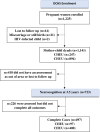Language outcomes of preschool children who are HIV-exposed uninfected: An analysis of a South African cohort
- PMID: 38598467
- PMCID: PMC11006185
- DOI: 10.1371/journal.pone.0297471
Language outcomes of preschool children who are HIV-exposed uninfected: An analysis of a South African cohort
Abstract
Introduction: There are approximately 16 million children who are HIV-exposed and uninfected (CHEU) worldwide. Studies suggest that CHEU are at risk for developmental impairment in infancy, particularly in language domains. However, there is limited research examining neurocognitive function in CHEU older than 2 years, including important pre-school years. This study aimed to investigate associations between HIV exposure without infection and neurocognitive outcomes and to determine risk factors for neurodevelopment in CHEU at age 3-4 years.
Methods: The Drakenstein Child Health Study is a South African population-based birth cohort which enrolled women in pregnancy with ongoing follow up. Neurocognitive outcomes were assessed in children at 3.5 years by trained assessors blinded to HIV status including general cognitive function, language, and memory, measured using the Kaufmann Assessment Battery for Children, Second Edition (KABC-II). Data were compared between CHEU and children who were HIV-unexposed uninfected (CHUU) using multivariable logistic and linear regression, including testing for effect modification; sex-stratified risk factor analyses were performed.
Results: A total of 497 children were included (97 [20%] CHEU; 400 [80%] CHUU; 50% male), with a mean age of 3.5 years (range 3.4-3.6). Groups had similar birth and household characteristics, although mothers of CHEU were older, on average. Overall, CHEU had lower expressive language scores compared to CHUU on unadjusted and adjusted analyses (effect size: -0.23 [95% CI -0.45, -0.01]). There were no group differences in general cognitive or memory function (p>0.05). On sex-stratified analyses, male CHEU were found to have higher odds of suboptimal cognitive development compared to male CHUU (aOR 2.28 [95% CI 1.06, 4.87], p = 0.034). Several other factors including birthweight, maternal education, maternal ART duration and HIV viral load during pregnancy were associated with cognition, memory, or expressive language outcomes in CHEU, dependent on child sex.
Interpretation: The findings suggest that perinatal HIV exposure continues to be associated with impaired language development across the preschool years, highlighting the importance of targeting early interventions to optimise language outcomes. Further, the results suggest the importance of demographic, biological and HIV-related variables influencing developmental outcomes in CHEU. The greater risk of suboptimal cognitive development in male CHEU requires investigation around sex-specific mechanisms.
Copyright: © 2024 Green et al. This is an open access article distributed under the terms of the Creative Commons Attribution License, which permits unrestricted use, distribution, and reproduction in any medium, provided the original author and source are credited.
Conflict of interest statement
DJS has received research grants and/or consultancy honoraria from Discovery Vitality, Johnson & Johnson, Kanna, L’Oreal, Lundbeck, Orion, Sanofi, Servier, Takeda and Vistagen. All other authors report no competing interests. This does not alter our adherence to PLOS ONE policies on sharing data and materials.
Figures



Similar articles
-
Neurodevelopment of children who are HIV-exposed and uninfected in Kenya.J Int AIDS Soc. 2023 Oct;26 Suppl 4(Suppl 4):e26149. doi: 10.1002/jia2.26149. J Int AIDS Soc. 2023. PMID: 37909174 Free PMC article.
-
Lower Neurocognitive Functioning in HIV-Exposed Uninfected Children Compared With That in HIV-Unexposed Children.J Acquir Immune Defic Syndr. 2022 Apr 1;89(4):441-447. doi: 10.1097/QAI.0000000000002881. J Acquir Immune Defic Syndr. 2022. PMID: 35202050 Free PMC article.
-
Higher Hospitalization Rates in Children Born HIV-exposed Uninfected in British Columbia, Canada, Between 1990 and 2012.Pediatr Infect Dis J. 2022 Feb 1;41(2):124-130. doi: 10.1097/INF.0000000000003365. Pediatr Infect Dis J. 2022. PMID: 34711783
-
Neurological development of children who are HIV-exposed and uninfected.Dev Med Child Neurol. 2021 Oct;63(10):1161-1170. doi: 10.1111/dmcn.14921. Epub 2021 May 14. Dev Med Child Neurol. 2021. PMID: 33987826 Review.
-
Neurodevelopment in children born to HIV-infected mothers by infection and treatment status.Pediatrics. 2012 Nov;130(5):e1326-44. doi: 10.1542/peds.2012-0405. Epub 2012 Oct 1. Pediatrics. 2012. PMID: 23118140 Review.
Cited by
-
Understanding HIV-Exposed Uninfected Children: A Narrative Review.Viruses. 2025 Mar 19;17(3):442. doi: 10.3390/v17030442. Viruses. 2025. PMID: 40143369 Free PMC article. Review.
References
-
- UNAIDS. AIDSinfo [cited 2023 15th December]. http://aidsinfo.unaids.org.
-
- UNAIDS. Women, adolescent girls and the HIV response. 2020.
-
- UNAIDS. 2022 [cited 2023 15th December]. https://www.unaids.org/en/resources/fact-sheet.
MeSH terms
Grants and funding
LinkOut - more resources
Full Text Sources
Medical

